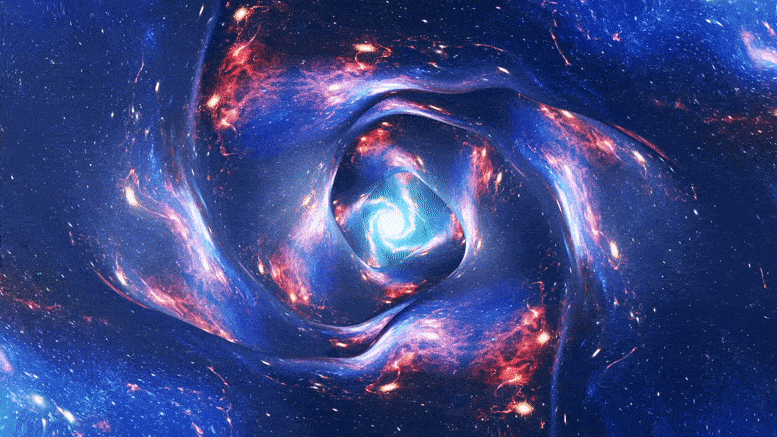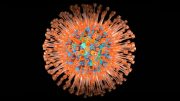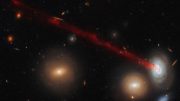
A groundbreaking study led by Alex Sicilia of SISSA has leveraged advanced models of stellar and binary evolution, along with empirical data on star formation and metal enrichment, to estimate that approximately 1% of the Universe’s ordinary matter is contained within stellar mass black holes, totaling around 40 billion billion black holes.
Recent research by SISSA has revealed that around 1% of the Universe’s ordinary (baryonic) matter is found in stellar mass black holes, with an estimated total of 40 billion billion such black holes. The study, utilizing new computational models and empirical data, also investigates the origins of the most massive black holes through dynamic stellar events.
How many black holes are out there in the Universe?
This is one of the most relevant and pressing questions in modern astrophysics and cosmology. The intriguing issue has recently been addressed by the SISSA Ph.D. student Alex Sicilia, supervised by Prof. Andrea Lapi and Dr. Lumen Boco, together with other collaborators from SISSA and other national and international institutions. In the first paper of a series just published in The Astrophysical Journal, the authors have investigated the demographics of stellar mass black holes, which are black holes with masses between a few to some hundred solar masses, that originated at the end of the life of massive stars.
“The innovative character of this work is in the coupling of a detailed model of stellar and binary evolution with advanced recipes for star formation and metal enrichment in individual galaxies. This is one of the first, and one of the most robust, ab initio computation of the stellar black hole mass function across cosmic history.” — Alex Sicilia, first author of the study
According to the new research, a remarkable amount of around 1% of the overall ordinary (baryonic) matter of the Universe is locked up in stellar mass black holes. Astonishingly, the researchers have found that the number of black holes within the observable Universe (a sphere of diameter around 90 billion light-years) at present is about 40 billion billion (i.e., about 40 x 1018, i.e. 4 followed by 19 zeros!)
A new method to calculate the number of black holes
As the authors of the research explain: “This important result has been obtained thanks to an original approach which combines the state-of-the-art stellar and binary evolution code SEVN developed by SISSA researcher Dr. Mario Spera to empirical prescriptions for relevant physical properties of galaxies, especially the rate of star formation, the amount of stellar mass and the metallicity of the interstellar medium (which are all important elements to define the number and the masses of stellar black holes). Exploiting these crucial ingredients in a self-consistent approach, thanks to their new computation approach, the researchers have then derived the number of stellar black holes and their mass distribution across the whole history of the Universe. Alex Sicilia, first author of the study, comments: “The innovative character of this work is in the coupling of a detailed model of stellar and binary evolution with advanced recipes for star formation and metal enrichment in individual galaxies. This is one of the first, and one of the most robust, ab initio computation of the stellar black hole mass function across cosmic history.”
What’s the origin of most massive stellar black holes?
The estimate of the number of black holes in the observable Universe is not the only issue investigated by the scientists in this piece of research. In collaboration with Dr. Ugo Di Carlo and Prof. Michela Mapelli from University of Padova, they have also explored the various formation channels for black holes of different masses, like isolated stars, binary systems, and stellar clusters. According to their work, the most massive stellar black holes originate mainly from dynamical events in stellar clusters. Specifically, the researchers have shown that such events are required to explain the mass function of coalescing black holes as estimated from gravitational wave observations by the LIGO/Virgo collaboration.
Lumen Boco, co-author of the paper, comments: “Our work provides a robust theory for the generation of light seeds for (super)massive black holes at high redshift, and can constitute a starting point to investigate the origin of ‘heavy seeds’, that we will pursue in a forthcoming paper.
A multidisciplinary work carried out in the context of “BiD4BESt – Big Data Application for Black Hole Evolution Studies”
Prof. Andrea Lapi, Sicilia’s supervisor and coordinator of the Ph.D. in Astrophysics and Cosmology at SISSA, adds: “This research is really multidisciplinary, covering aspects of, and requiring expertise in stellar astrophysics, galaxy formation and evolution, gravitational wave and multi-messenger astrophysics; as such it needs collaborative efforts from various members of the SISSA Astrophysics and Cosmology group, and a strong networking with external collaborators.”
Alex Sicilia’s work occurs in the context of a prestigious Innovative Training Network Project “BiD4BESt – Big Data Application for Black Hole Evolution Studies” co-PIed by Prof. Andrea Lapi from SISSA (H2020-MSCAITN-2019 Project 860744), that has been funded by the European Union with about 3.5 million Euros overall; it involves several academic and industrial partners, to provide Ph.D. training to 13 early stage researchers in the area of black hole formation and evolution, by exploiting advanced data science techniques.
Reference: “The Black Hole Mass Function Across Cosmic Times. I. Stellar Black Holes and Light Seed Distribution” by Alex Sicilia, Andrea Lapi, Lumen Boco, Mario Spera, Ugo N. Di Carlo, Michela Mapelli, Francesco Shankar, David M. Alexander, Alessandro Bressan and Luigi Danese, 12 January 2022, The Astrophysical Journal.
DOI: 10.3847/1538-4357/ac34fb









Why are we even reading about this when there are NO black holes.
The Universe is a black hole filled with Electric Magnet Plasma
the rest is detritus of Gods creation.
So according to you “…there are NO black holes…” yet the universe “…is a black hole…”?
Nothing more to say really! This is the true quality of deist thought.
To which fake sky fairy are you referring? Zeus, Apollo, Hera, the FSM, Yahweh, Baal, etc. Please clear this up for us so we can know how to respond to your unsupportable beliefs
No. No it actually isn’t.
Electric universe theory and plasma cosmology don’t align with observed phenomena at all. They’re interesting ideas, but to champion them as truth just makes you a crackpot.
Now we know how many black holes can fill Albert Hall….
Are you sure it’s not 42
Billion billion?
If this number is relatively close to the number of stellar mass black holes, what about all the black holes that are each billions of times larger than stellar mass? How much baryonic mass would they represent?
Also, since we haven’t ever been able to observe anything beyond 13.5 billion light years away, perhaps they should stop saying the universe is 90 billion light years in diameter. While a larger size is highly probable, without any direct observations whatsoever, we really don’t have any proof of that.
The James Webb Space Telescope may help us refine the numbers on the overall size of the Universe but for now, most of what we “know” is based much, much, much more on guesswork and conjecture than it is on actual collected data.
Black Holes, Asteroids, and Hemorrhoids! We’ve been hoodvvinked and KORNHOLD!
4×10 power 19 black holes is perhaps the minimum number of galaxies, each galaxy being available for umpteen million stars each with assorted planets only one of which was put here for Adam and Eve to populate aided by a snake and an Apple Tree….you mean there is no other life in the universe, God?
The collaborative effort alone has the most proof of review, and little can be argued just because others minds are made up. the article said observable universe and we are not even close to seeing a full picture and may never, simply because the vastness of the universe that can not even be worded for size. If we had seen the edge of the universe we would be probing a unknown facet of expansion. I do compare black holes to bubbles in a soda and possibly the unseen nature of the phenomenon of the black hole is a manifestation of what is outside the edge of the universe.